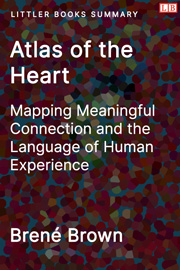Book Description
A thought-provoking and insightful exploration of the power of emotion and vulnerability.
If You Just Remember One Thing
Coming soon.
Bullet Point Summary and Quotes
- It is important to gain clarity on the emotions we feel, so that they don't overwhelm us and make us feel lost.
- The author, Brené Brown, developed a keen sense of emotional awareness as a child because she grew up with people who were susceptible to emotional outbursts. Her swim coach had an explosive temper and Brown's peers did not know why. However, Brown noticed the outbursts would happen when he saw someone not trying hard enough. At home, Brown's parents were unpredictable and got upset frequently, and Brown became good at identifying their sensitive soft-spots, or what she calls "shame triggers". Brown also realized the outbursts were not completely caused by the situation at hand (e.g., road rage), but there's always a deeper underlying reason why they became emotional.
- Brown felt like she was always walking on eggshells because of her hypersensitivity to other people's emotions. To suppress the anxiety and fear brought upon by her sensitivity, she engaged in vices like smoking and drinking. However, she quickly realized that her unhealthy lifestyle made her feel even worse. She corrected herself, stopped her bad habits, started therapy, learned to embrace her feelings, and her life improved dramatically.
- Imagine going to see a doctor for pains in your shoulder, but you cannot speak to the doctor and you can only wave and point. This will leave you frustrated and still with a bad shoulder. Describing our emotions with accurate language is just as important as describing physical pain, but many of us are not equipped to do so. Researchers asked 7,000 people to identify all the emotions they experience, and on average they can only name three -- sad, angry, and happy.
- The ability to use the right language to express your emotions is called "emotional granularity". It helps you to get the help that you need, identify where your feelings are coming from, what your triggers are, and ways to comfort yourself. Having this tool will also make you feel more connected to yourself and to other people.
- Sadness is a feeling that sometimes umbrellas more specific feelings like anguish, grief, hopelessness, or despair. It is important to identify the feeling you're experiencing with the most specific term, because even though the feelings can all be grouped under sadness, they are all different and require different responses.
- Anguish is often unexpected and traumatic, and can affect us on a physiological level. It "comes for the bones".
- Grief is a profound sense of loss.
- Hopelessness is the feeling of finding your goals impossible to achieve.
- Despair is thinking that life itself is hopelessness and that nothing will change. Despair can drive people to be suicidal as they believe that's the only agency they can have on their lives.
- Hope is a skill that can be learned to deal with negative emotions. You can be more hopeful by setting realistic goals and meeting them.
- Hopefulness is also infectious. Study shows that children of hopeful parents are also hopeful.
- Another coping technique is called "the 3 Ps". When you're having negative emotions in a situation, think of its personalization (this is not really about me personally -- what are the other factors?), permanence (this probably won't matter in a minute/hour/month/year), and pervasiveness (this only affects a small area of my life, and doesn't hurt my family/relationships/work/etc.).
- We learn to be more vulnerable and empathetic from experiencing and dealing with sadness. It is not a bad thing.
- Happiness is more of a trait or a long-term emotional state from feeling in control than a temporary feeling. Joy is an unexpected happy feeling, usually with high intensity and more short term.
- Feeling joy sometimes is so overwhelming that we develop foreboding joy, an irrational fear for something terrible to happen as to no longer being able to experience the current joy. For example, a parent might feel joy when they're watching their sleeping children, but they might also be suddenly fearful of something bad happening to them.
- We should appreciate what we have in the moment and try not to let the pessimistic thoughts tarnish the joyful present.
- Joy and gratitude comes hand in hand. Research shows people who show more gratitude experience more joy, and vice versa, thus creating an "upwards spiral".
- Feeling gratitude is also a skill. You can practice it by keeping a gratitude journal, or listing a few things you're grateful for at the end of the day.
- The rational part of the brain deactivates when there is overwhelming emotion. It is crucial to have time-outs and take a breather during these moments, especially when important matters are being discussed.
Atlas of the Heart: Resources
- Download this summary and 173+ other top nonfiction book summaries in one book (PDF, eBook, DOCX)
- Buy the book
